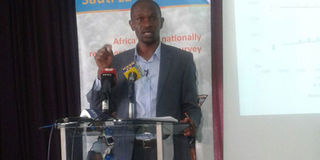Access to clean water in towns has declined, survey reveals

Twaweza East Africa Programme Manager Victor Rateng on March 21, 2017 during the release of a report on Water, Sanitation and Hygiene in Nairobi. PHOTO | COLLINS OMULO | NATION MEDIA GROUP.
What you need to know:
- This was attributed to high rate of population growth in Kenya’s towns and cities without corresponding infrastructural development to keep pace with the rapid population growth in urban areas.
- The report revealed that the task of collecting water was borne primarily by women and children in over nine in ten households with the figures almost similar in both rural and urban areas.
Access to clean and safe water in urban Kenya has been declining for the past 25 years, a report has revealed.
The report, Water, Sanitation and Hygiene in Kenya, by Twaweza East Africa showed that the levels of access to clean and safe water in urban areas had been declining from around 90 per cent in 1990 to about 78 per cent today.
This was attributed to high rate of population growth in Kenya’s towns and cities without corresponding infrastructural development to keep pace with the rapid population growth in urban areas.
“This does not bode well for the future as more and more citizens find themselves drawn towards Kenya’s cities, which already contain dense, underserved populations,” said Victor Rateng, Twaweza East Africa Programmes Manager while addressing journalists during the release of the results in Nairobi on Tuesday.
However, the report indicated that there has been a steady improvement in access to clean and safe water in Kenya where at least two-thirds or 68 per cent of Kenyans get their water from an improved water source, that is, piped water, protected wells and springs, and rain water.
In rural areas, this access had improved from 37 per cent in 2009 to 62 per cent or six in ten households in 2015.
But a clear link between wealth and access to clean and safe water persists with 87 per cent of the richest households having access compared to only 48 per cent of the poorest households.
But even as the World prepares to mark World Water Day on Thursday, water still remains a fundamentally gendered issue with women bearing primary responsibility of making sure that households have water.
The report revealed that the task of collecting water was borne primarily by women and children in over nine in ten households with the figures almost similar in both rural and urban areas.
“For 71 per cent of Kenyan households, the responsibility of collecting water is borne by either the female head of household or wife to the head of household. In a further 21 per cent of the households, the responsibility falls on children,” he said.
Distance to water points, insufficient numbers of water points and irregular supply still remain a big challenge.
The survey revealed that 48 per cent of those living in the rural areas pointed to the distance to water points as a major challenge while 32 per cent in urban areas mentioned irregular supply as one of the main problems.
Majority of households in urban areas, 78 per cent, were able to collect water within 30 minutes, while only 12 per cent spent an hour or more.
This is markedly different in rural Kenya, where the time spent collecting water was much longer with one in four, 26 per cent, households spending an hour or more — one in five or 20 per cent spend between 30 and 60 minutes while slightly more than half, 54 per cent, are able to get their water within a 30-minute period.
According to the survey done between November 5 and 28, last year, a majority of Kenyan households, 65 per cent, reported treating their water before drinking with boiling water and use of chemical disinfectants (such as WaterGuard) most preferred at 44 per cent and 39 per cent respectively.
The 35 per cent who did not treat their water said that the water was either safe for drinking or they lacked resources to do so.
The research covered 1, 741 Kenyan adults aged 18 years and above living in rural and urban areas with mobile phone coverage in all the 47 counties through random sampling method and conducting computer aided telephonic interviews with results of +/-2.4 margin of error and 95 per cent confidence level.





